Goudou Goudou (5)
By:
December 13, 2010
Fifth in a series of posts.
A young man holds an old rock, a chunk of his fallen home. Haiti is a cascading sea of shifting stone, and in that rubble hides a shoe, a photo, a doll, a Bible, the odd bits and treasures of many lives. The city wants to clear the streets of the wreckage, but the man considers this theft. Each rock has an owner, somewhere. Rubble isn’t cheap. Rubble has a certain currency.
All the “rubbles” — Haitians have pluralized the word — look alike. It is and isn’t the same. The young man has a blue track shirt checked with the Nike logo. He shows me a speck of green on the rock he holds, points to the tumbling green walls of his home. Green paint: his rock. He points to his neighbor’s walls: pink. He adds the green rock to his pile. The sun is high, the chalky air shimmers with dust, and above, the remnants of arches and pillars that two weeks ago framed majestic rooms have been reduced by the earthquake to silhouettes, now merely suggestive of grandeur, like the architectural paintings of Chirico.
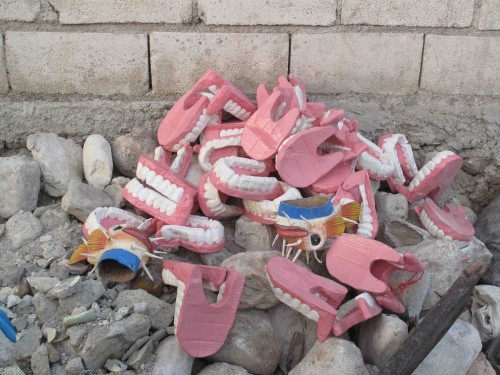
Days in Haiti are ever interrupted by something surreal, something that causes pause. A pile of tooth molds. A smashed tap tap bus, the painted portrait of Tupac Shakur barely recognizable in the ripples of crunched metal. A toilet atop a rubble pile. Girly portraits on a beauty salon wall, chunks of faces missing. It’s hard to breathe.
The young man kneels to sort the rocks. He is hopeful for Haiti. Things cast asunder simply need to be put back. Pink paint flecks to the left, green to the right. He finds a photo of a woman sitting in a chair. It’s not his. He wanders up the street, gazing from house to house. He’ll make sure that photo finds its way home, into the hands of someone that loved her.
While op-eds and reports are written, and foreign aid arrives in thin trickles and drips, Haitians are rebuilding Haiti. This man will, stone by stone, rebuild his home.
Every day I take a mototaxi to a tent where I teach film. This morning the driver is delicate as a girl, draped in bling, and tells me he loves me. I tell him that’s a good thing. We laugh. On the ride to my tent I teach him cow, house, horse, boy, car, good thing. He teaches me bèf, kay, chwal, ti gason, machin, bon bagay. I get off the bike, tell him I love him, and say goodbye.
Whipping along on a motobike in Haiti is like surfing the waves of an alien landscape. Perfect serene buildings stand untouched between the spillage of the buildings that used to frame them. The homes still upright stand spared and humble, apologetic and fearful. The terrain is a grimace with many missing teeth.
Under a slab that was once a roof, a man is using some large rocks as a table for his sandal repair business. Sandals will still need to be fixed. He will fix them. Women limp in with broken shoes, stride out confident.

In front of the rubble of what was the Jesus Loves Hair Salon girls sit and tame each other’s unruly hair into mazes of tight braids. There has been a terrible earthquake, but women need to look beautiful. Even more so. I am always startled to see the women emerge from the muck of the tent camps, looking gorgeous.
A small boy crawls out from under a tarp with a pull-car made from a milk jug, intent on pleasure. His father has picked in a garbage pile to make his son a toy. Life does not stop, even when it does.
Goats have taken over the precipitous rooftops of half-fallen buildings. The goats have burning yellow eyes and seem slightly cross-eyed, a look of madness. Dogs sit in the shade of cool hollows made from collapsed buildings. Animals know when something bad is coming, hide while it hits, and adjust the instant it is over.
A man sells jugs of gasoline in the shade of an abandoned bus. A hole in a wall reveals an exposed bedroom; a bed, a chair, a painting. A woman sits on the bed. A sense of still life. No matter the walls gone, it is still life.
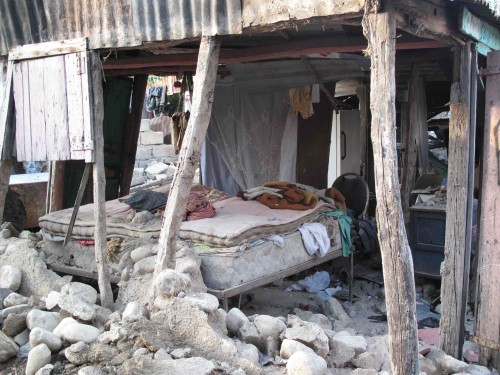
Schoolchildren scramble over ruins to enter a temporary school tent, colorful Spider-man and Hello Kitty backpacks bouncing. A blue tarp stretched across mismatched poles makes a three-legged beast of a tilting home, under which a woman sits with a bubbling, steaming pot over a fire made from sticks gathered that day and the day before and again the next. She lays her laundry over hot rocks to dry. Rows of small T-shirts, children’s underwear. She’s lost her home, but her children will come “home” to clean clothes, a hot meal.
The world collapses, life goes on. Life, despite. Things are rearranged into the perfect calculus of life despite. As if there is a cosmic calculation behind where things fall and how they rise. A pile of sticks, a plume of smoke. A kid rolls a hoop toy. Balmy lazy moments. Everywhere the eye gazes is destruction and life despite. The scrappy resourcefulness of crafty boys picking through rubble, liberating scraps of metal to be traded for a meal. The chicken scratch of survival.
After a disaster, things rearrange themselves along peculiar pathways. Private spills into public, a random redistribution of objects. When the World Trade Center Towers fell, those of us in the street that day watched, among other things, a rain of paper. I caught some of it in the air. The paper clutter of someone’s in-box: bills, memos, letters. What to do with this? The flotsam of a life. The paper trail of someone no longer with us. Is it presumptuous to assume it is valueless now? Or does it belong to the communal archive of catastrophe?
Once a great flood came and went, snatching rakes and lawn chairs, carrying off the boats, ladders and oars that littered my lawn. What the flood left behind for me was a red plastic car stuck high in a tree, a cow-shaped lawn tchotchke, a rusted jug brimming with soaked chicken feed. The detritus of a flood. I wondered who had received the surprise bequest of my boat.
I carried the cow tchotchke up the road to my neighbor’s home. His trailer was pounded by the flood, now so toxic with mold it has been condemned. He stood atop the trailer, eyes wild, sledgehammer in hand, smashing his home. Is this yours? I asked, handing him the cow. He stared at it. I could sense him emerging from a tunnel of rage to focus on my mundane offering. He sits. My wife, he says, she’ll be so happy this came back. He holds the cow close. I think he will cry, so I leave him.
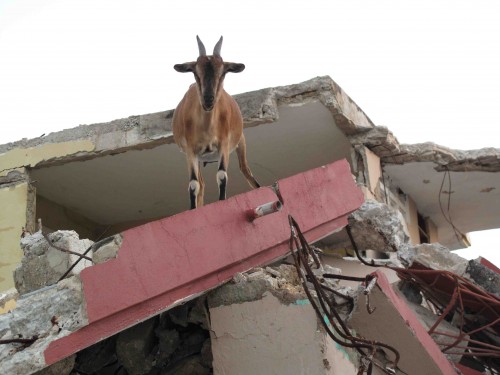
What does the invisible government of Haiti plan to do to restore dignity to the damaged historic districts? The buildings stand proud despite their awkward skirts of rubble. I’ve been seeing marks on buildings that remind me of post-Katrina New Orleans: X’s and numbers, a count of those killed, those rescued. But now there are dots, circles: black, green, yellow, red. The X’s are alarming. What do they mean?
I wander Jacmel’s historic district with two of my students, Ilrique “Fouki Fouka” and Huguens, filming the buildings. We interview the owner of the Hotel Florita, who is restoring the fallen parts of his building despite a city injunction. Axelle, an elegant high-toned Haitian dressed in tulip shades: magenta shirt, crimson dress, burgundy shoes, fuchsia lips; her home pink brick and rust-metal and peach paint. She tells us of the cast iron structure, imported from Scotland a hundred years ago, the robust skeleton that secures her building. She shows us how many of the cracks in the walls are superficial, and yet the city has stamped her façade with the deadly red dot. All over Haiti this is how families found out their homes were marked for destruction: shocked by a red X in a dot. How does one stand down a bulldozer? “In certain countries,” says Axelle, “bulldozing a house is considered an act of war.”
Black dot: okay; red dot: destroy; yellow dot: who knows?
Whose rubble is it, anyway? Whose tragedy, whose problem? Misery is the new currency. No one would begrudge the fancy rentals, pools, SUVs, fat salaries of the multiplying aid organizations, if things got done. But humanitarianism is quite a racket. Misery is the commodity for sale and competed over. Misery inspires a bidding war among foreign contractors. The money pours in, the misery remains untouched.
Later, the same stranger who brought me to school drives by. I don’t need a ride, but he insists, takes me to the bar down the road. He says, do you still love me? Of course, I tell him, always. We laugh. I will never see him again.
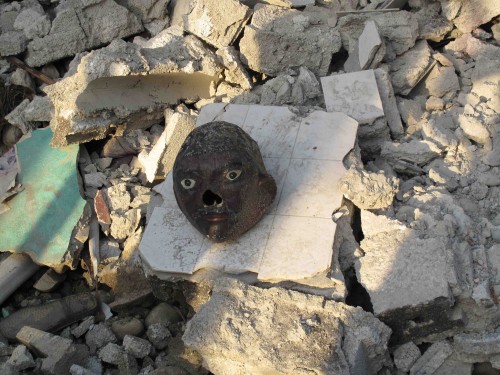
Sitting in the bar I meet a crew of guys on a volunteer trip from England, here to build shelters. One guy complains about how badly the buildings were built, that it’s the Haitians fault they fell. They see the rock piles as monuments to failure. Another feels slighted: no one thanked him after he worked all day. Is that why you came? To be thanked? Yes, he says, drunk, pounding the table. I want to be properly thanked.
I spend time with the OCHA UN Ministry “clusters” as they are called. Shelter clusters, food cluster, migration clusters. Well-meaning, bitter, frustrated, resentful, all types. The conversations are endless regressions of logic. They expect people to know things. In a tent in the middle of nowhere with nowhere to charge a phone, a radio, what can you know?
In Haiti a few gourdes are scraped together to buy some minutes for a phone. The minutes run out. Everywhere Haitians say: I’ve run out of minutes.
No more time, Haitians say. I’ve run out of minutes.
Humanity is messy. Need, want, desire, desperation. All tumbled up with art, music, solidarity, delusion, evil, theft, inspiration, tears, whining, failure,
psychosis, solitude, brilliance, suffering, luck, lack, hunger, persistence.
I walk into a light that is too delicate to be light, or too dense to inhabit. The kind of light and heat so thick the air seems to be made of something, the world a whitewashed fade. A world anointed. I have a yearning to disappear.
The next day when I get to my school tent the students are gone. Someone has assigned them the job of sorting a mountain of mismatched shoes from an aid shipment. It is a colossal waste of time. We have movies to make, history to document. But somehow someone in charge somewhere has a need for the mismatched shoes to be matched. It is a monumental bit of illogic, but a lunacy that just has to play out. My students miss ten days of school for this bit of conjured folly.
Months later, the rubble is still everywhere. Down by the beach, artisans are doing delicate paintings on chunks of rubble and shards of glass.
Earthquake art, they call it. I buy a few shards.
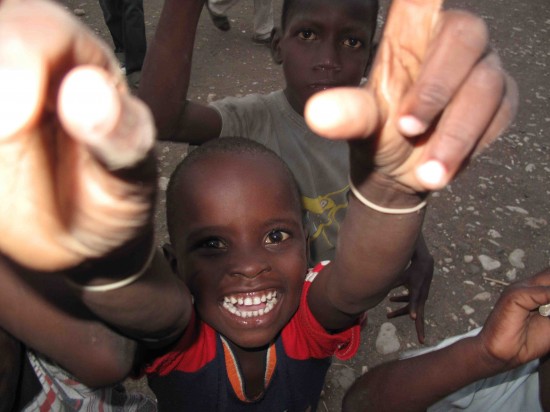
NEXT: Condom Lumière: a story of many lights.
To see “A Legacy Under Rubble” click here.
